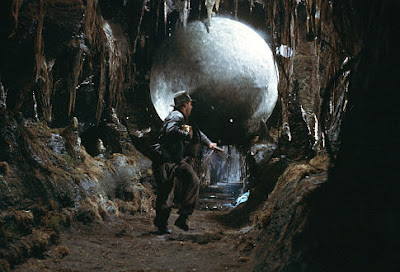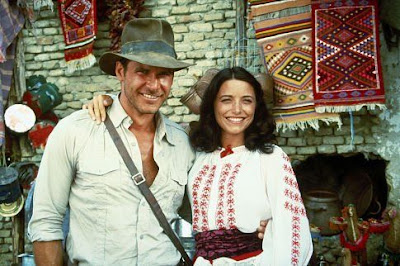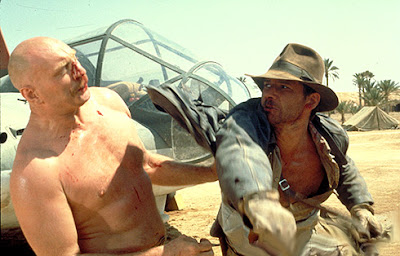A couple of weeks back I posted my “10 Great Things About Die Hard” article and you guys responded. To quote Sally Fields: “You loved it! You really loved it!” Since I had so much fun breaking the movie down, you can expect this to be a semi-regular feature, and today I’m following it up with a film I’ve always wanted to dissect: Raiders Of The Lost Ark.
When it comes to summer action movies, there aren’t too many films that hold a candle to the perfectly crafted Raiders. Many have tried, and while some have cleaned up at the box office (Mummy, Tomb Raider
) they haven’t remained memorable past the summer they were released.
So what makes Indiana Jones such a classic? What makes this character one of the top ten movie characters of all time? Here are ten screenwriting choices that made Raiders Of The Lost Ark so amazing.
THE POWER OF THE ACTIVE PROTAGONIST
At some point in the evolution of screenwriting, a buzz word was born. The “active” protagonist. This refers to the hero who makes his own way, who drives the story forward instead of letting the story drive him. I don’t know when this buzz word became popular exactly, but I’m willing to bet it was soonafter Raiders debuted. One of the things that makes Indiana Jones such a great character is how ACTIVE he is. In the very first scene, it’s him who’s going after that gold idol. It’s him driving the pursuit of the Ark Of The Covenant. It’s him who decides to seek out Marion. It’s him who digs in the alternate location in Cairo. Indiana Jones’ CHOICES are what push this story forward. There’s very little “reactive” decision-making going on. And the man is never once passive. The “active” protagonist is the key ingredient for a great hero and a great action movie.
THE ROADMAP TO A LIKABLE HERO
Indiana Jones is almost the perfect character. Believe it or not, however, it isn’t Harrison Ford’s smile that makes Indy work. The screenplay does an excellent job of making us fall in love with him, and does so in three ways. 1) Indiana Jones is extremely active (as mentioned above). We instinctively like people who take action in life. They’re leaders. And we like to follow leaders. 2) He’s great at what he does. When we see Indiana cautiously avoid the light in the cave, casually wipe away spiders, or use his whip to swing across pits, we love him, because we’re drawn to people who are good at what they do. And 3) He’s screwed over. This is really the key one, because it creates sympathy for the main character. We watch as our hero risks life and limb to get the gold idol, only to watch as the bad guy heartlessly takes it away. If you want to create sympathy for a character, have them risk their life to get something only to have someone take it from them afterwards. We will love that character. We will want to see him succeed. I guarantee it.
ACTION SEQUENCES
When you think back to Indiana Jones, what you remember most are the great action sequences. Nearly every one of them is top notch. And there’s a reason for that. CLARITY . Each action sequence starts with a clear objective. Indiana tries to get the gold idol in the cave. Indiana must save Marion in the bar. Indiana must find the kidnapped Marion in the streets of Cairo. Indiana must destroy the plane that’s delivering the Ark. It’s so rare that we see action sequences these days with a clear objective, which is why so many of them suck. Look at Iron Man 2 for example. What the hell was that car race scene about? We have no idea, which is why despite some cool lightning whip special effects from Mickey Rourke, the scene sucked. Always create a clear objective in your action scenes.
REMIND YOUR AUDIENCE HOW DIFFICULT THE GOAL IS
High stakes are primarily created by crafting a hero who desperately wants to achieve his goal. I don’t know anyone who wants anything as much as Indiana Jones wants that Ark. But in order to build those stakes even higher, you want to remind the audience just how important and difficult it will be for your hero to achieve that goal. For example, there’s a nice little quiet scene in Raiders right before Indiana goes on his journey where his boss reminds him what finding the Ark means. “Nobody’s found the Ark in 3000 years. It’s like nothing you’ve gone after before.” It’s a small moment, but it’s a great reminder to the audience. “Whoa, this is a really big freaking deal.”
IGNORE THE RULES IF IT SUITS YOUR STORY
Part of becoming a great screenwriter is learning when rules don’t apply to the specific story you’re telling. Each story is unique and therefore forces you to make unique choices. One of the commonly held beliefs with any hero journey is that there must be a “refusal of the call.” When Luke is given the chance to help Obi-Wan, he backs down, “I can’t do that,” he says. “I still have to work on the farm.” Indiana Jones, however, never refuses the call. And Raiders is a better movie for it. Because the thing we like so much about Indiana Jones is that he’s gung-ho, that he’s not afraid of anything. So if the writers had manufactured a “refusal of the call” moment, with Indy saying, “But I have to stay here and teach. I have a dedication to the university,” it would’ve felt stale and forced. So whenever you’re trying to incorporate a rule into your story that isn’t working, consider the possibility that you may not need it.
GIVE A GREAT INTRO TO YOUR FEMALE LEAD
I can’t tell you how many male writers make this mistake (and how many female writers make this mistake in reverse). You need to put just as much thought into your female lead’s introductory scene as you do your male’s. Raiders is a perfect example of this. Indiana Jones has one of, if not the, greatest introductory scene in a movie ever. If you don’t give that same dedication and passion to Marion’s introduction, she’s going to disappear. That’s why, even though her entrance doesn’t compare to Indiana’s, it’s still pretty damn good. We have the great drinking competition scene followed by the battle with German/Nepalese thugs. The girl is badass, swallowing rum from a bullet hole leak in the middle of a life or death battle! Always always always give just as much thought to your female introduction as your male’s.
ADD IMMEDIACY AT EVERY TURN
The pace of Indiana Jones still holds up today, 25 years later. Not an easy task when you’re battling with the likes of Michael Bay and Steven Sommers, directors who have ruined audience’s attention spans with their ADD like cutting. Raiders achieves this pace not through dizzying editing tricks, but through good old fashioned story mechanics, specifically its desire to add immediacy to the story whenever the opportunity arises. Take when Indy arrives in Cairo for example. The first thing he’s told when he gets there is that the Germans are close to finding the Well of Souls! What?? This was supposed to be a simple one-man expedition! Now he’s in direct competition with a team of hundreds of men??? Because of this added immediacy, the stakes are raised and Indiana’s pursuit of his goal is more entertaining. So always look to add immediacy to your action movie where you can!
IF YOU HAVE A BORING CONVERSATION, INJECT SOME SUSPENSE INTO IT
You are always going to have two person dialogue scenes in your movie. These scenes can get very boring very quickly, especially in an action film. There’s a scene after Indy and Marion get to Cairo where they walk around the city. Technically, we don’t need this scene but it does help establish the relationship between the two, which is important for later on. Now a lesser writer may have sat these two in a room and had them divulge their pasts to each other in a boring explosion of exposition. Instead, Kasdan has them walking around, and *cutting to various bad guys getting in position to attack them.* This adds an element of suspense to the conversation, since we know that sooner or later, something bad is going to happen to our couple. MUCH more interesting than a straight forward dialogue scene between your two leads.
MOVING ON FROM DEATH IN AN ACTION MOVIE
Many times you’ll run into an issue where a major character in your movie dies. Yet you somehow must make us believe that your hero is willing to continue his journey. The perceived death of Marion creates this problem in Raiders. The formula to solve the problem? A quick 1-2 page scene of mourning, followed by the hero being placed in a dangerous situation. The mourning shows they properly care about the death, then the danger tricks the audience into forgetting about said death, allowing you to jump back into the story. So in Raiders, after Marion “dies,” Indiana sits back in his room, depressed, then gets a call from Belloq. The dangerous Belloq questions what Indie knows, followed by the entire bar prepping to shoot him. After that scene you’ll notice you’ve sort of forgotten about Marion, as crazy as it sounds. This exact same formula is used in Star Wars. Obi-Wan dies, we get the quick mourning scene on the Falcon, and then BOOM, tie fighters attack them, seguing us back into the thick of the story.
INDIANA’S ONE FAILURE – CHARACTER DEVELOPMENT
Raiders is about as perfect a movie as they come. However, it does drop the ball on one front. Indiana Jones is not a deep character. Now because this is an action movie, it doesn’t really matter. However, I’d argue that the script did hint at a character flaw in Indiana, but ultimately chickened out. Specifically, there’s a brief scene inside the tent when Indiana discovers Marion is still alive. This presents a clear choice: Take Marion and get the hell out of here, or keep her tied up so he can continue his pursuit of the Ark. What does he do? He continues his pursuit of the Ark. This proves that Indiana does have a flaw. His pursuit of material objects (his work) is more important to him than his relationships with real people (love). However, since this is the only true scene that presents this flaw as a choice, it’s the only time we really get inside Indiana’s head. Had we seen a few more instances of him battling this decision, I think Raiders would’ve hit us on an even deeper level.
Tune in next week when I dissect Indiana Jones and The Kingdom Of The Crystal Skull!






